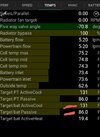Hello everyone,
New to Tesla here! Just got my Model Y (Long range) and went on a long road trip 300 miles or so down and back a couple days later. When traveling down to my destination i had to stop at a supercharger that tesla recommended(Thousand oaks), about 5 minutes before arriving on the dashboard it read, "Preconditioning battery etc..." the location was Thousand Oaks. a couple days pass and i head back home and stop at the SAME supercharger inputting the same location into the navigation. Before arriving the "Preconditioning battery" did not come on at all? Is that normal? the temp was higher that day to maybe my regular driving heated the battery enough to accept a high rate of charge? I made sure that the navigation was going to a tesla supercharger to make sure it preconditioned the battery. Is this common ? or is it only when the car deems necessary that it will precondition a battery when input through tesla supercharger? Does preconditioning do nothing when temps are around 75?
Secondly, When arriving at the same supercharger on the second time (Thousand Oaks) i plugged in the car and the rate was half of what it was the first time i plugged in the car on the way down. The chargers there are the Gen 3 as it only has one charger coming from the stand. I plugged in the car and it said it would only charge to 80% because there were zero stalls left 24/24 had been taken when i pulled in. Is the rate of charge reduced when all stalls are taken? even with Gen 3? Also, it took significantly longer to charger because on average it was giving me 180 miles/hour.. vs 440 on my way down. Does the supercharging bill only account for how much energy is consumed into the car vs the time? because this charging trip took twice as long...
Lastly, on the trip back i was less worried about conserving energy and more focused on getting home from the long weekend. My speed stayed around 80+ even through some pretty high hills (Santa Barbara). As expected my WH/MI was significantly higher than my trip down. When plugging into my charger and setting the limit to 100 i noticed i lost about 3 miles of range from 100% as before? does Tesla use their 100% range indication based on recent driving style? or is this me losing battery range with a new vehicle? BTW i do not charge to 100 i was just interested in seeing if it had changed.
-Kaz
New to Tesla here! Just got my Model Y (Long range) and went on a long road trip 300 miles or so down and back a couple days later. When traveling down to my destination i had to stop at a supercharger that tesla recommended(Thousand oaks), about 5 minutes before arriving on the dashboard it read, "Preconditioning battery etc..." the location was Thousand Oaks. a couple days pass and i head back home and stop at the SAME supercharger inputting the same location into the navigation. Before arriving the "Preconditioning battery" did not come on at all? Is that normal? the temp was higher that day to maybe my regular driving heated the battery enough to accept a high rate of charge? I made sure that the navigation was going to a tesla supercharger to make sure it preconditioned the battery. Is this common ? or is it only when the car deems necessary that it will precondition a battery when input through tesla supercharger? Does preconditioning do nothing when temps are around 75?
Secondly, When arriving at the same supercharger on the second time (Thousand Oaks) i plugged in the car and the rate was half of what it was the first time i plugged in the car on the way down. The chargers there are the Gen 3 as it only has one charger coming from the stand. I plugged in the car and it said it would only charge to 80% because there were zero stalls left 24/24 had been taken when i pulled in. Is the rate of charge reduced when all stalls are taken? even with Gen 3? Also, it took significantly longer to charger because on average it was giving me 180 miles/hour.. vs 440 on my way down. Does the supercharging bill only account for how much energy is consumed into the car vs the time? because this charging trip took twice as long...
Lastly, on the trip back i was less worried about conserving energy and more focused on getting home from the long weekend. My speed stayed around 80+ even through some pretty high hills (Santa Barbara). As expected my WH/MI was significantly higher than my trip down. When plugging into my charger and setting the limit to 100 i noticed i lost about 3 miles of range from 100% as before? does Tesla use their 100% range indication based on recent driving style? or is this me losing battery range with a new vehicle? BTW i do not charge to 100 i was just interested in seeing if it had changed.
-Kaz



